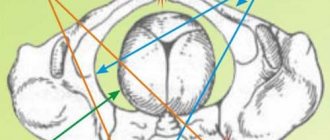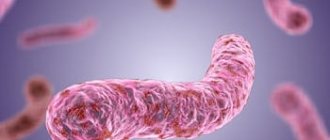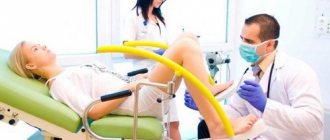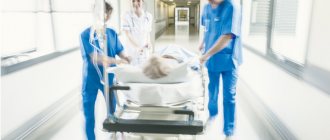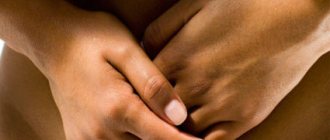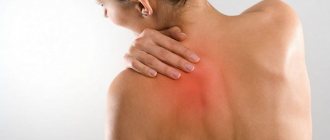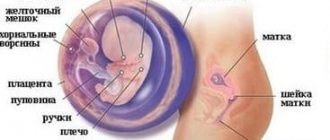Everyone has heard about premenstrual syndrome and painful periods, but few people know that ovulation can also be accompanied by unpleasant sensations, in particular pain of varying intensity. Many women simply do not attach any importance to this, since the pain is short-lived and mild and goes away on its own. “Knowledgeable” women use this feature of the body as a kind of control over childbirth. In some cases, the pain can be quite severe and debilitating. Do I need to worry in this case, do I need to consult a gynecologist?
The nature of pain during ovulation. Pain during ovulation can be felt for several minutes or hours, or for a couple of days; the physiological characteristics of the body are decisive here. If they do not go away, you need to seek help from a gynecologist. Typically, pain in the lower abdomen occurs on the side of the ovary in which the egg has matured (the sides may change accordingly).
If the menstrual cycle is regular, then ovulation occurs on the fourteenth day of the 28-day cycle, but it can also occur on the 10-11th day of the cycle, which can be influenced by reasons such as intense sexual intercourse, stress, hormonal imbalance, diets, illnesses, excessive physical exercise. Ovulation may also occur later due to hormonal imbalances. So, with the onset of ovulation, pain occurs, the nature of which can be very different (acute, sharp, strongly or mildly expressed, acute, dull, aching). I repeat, not all women experience pain during the release of the egg from the ovary into the body cavity when the follicle ruptures. But there are also those who during this time lose all ability to work or may even lose consciousness.
Symptoms of ovulation. In addition to unpleasant pain in the lower abdomen (right or left, depending on the activity of one or another ovary), a woman may experience an increase in her own libido, an increase in the secretion of mucus from the vulva and a change in their color (pinkish or reddish). All these manifestations of ovulation signal that the woman’s body is ready to conceive.
Causes of pain during ovulation. The maturation of the egg precedes the process of ovulation. When the walls of the maturing egg follicle are stretched to their maximum, a woman may experience pain at this moment.
Ruptures of blood vessels located at the base of the ruptured follicle can also provoke pain during ovulation. As a result of the rupture, the fluid from the follicle ends up on the abdominal wall and the epithelium of the uterus, which has an irritating effect; against this background, the uterus contracts and provokes pain of varying intensity. Sometimes small amounts of blood may appear in the discharge after ovulation, which is explained by a decrease in estradiol levels and a slight detachment of the endometrium.
Pain during or after ovulation may be a symptom of one of the existing gynecological diseases, a sign of the presence of inflammation of the reproductive organs (in particular cystitis, mastopathy, ectopic pregnancy, varicose veins in the pelvic area, etc.), and sometimes oncological diseases (ovarian cancer and cervix). There is no need to attribute everything in advance to natural manifestations of ovulation; be vigilant.
Pain in the right side of an aching, and often cutting, nature can be symptoms of appendicitis, only they are accompanied by an increase in body temperature (lasts for 12 hours), so if you have similar symptoms on your face, you should not blindly attribute them to ovulation, contact your doctor.
Excessive pain sensitivity and adhesions in the pelvis cause pain during ovulation.
If pain in the lower abdomen is combined with the appearance of bloody discharge (in rare cases, bleeding) from the vagina, do not hesitate, consult a gynecologist, as this condition may indicate the existence of diseases such as a cyst in the cervical canal area, endometritis (myometrium).
Is pain during ovulation dangerous? Painful manifestations during ovulation are exclusively physiological in nature, they do not threaten the woman’s health, and therefore do not require specific treatment. If this is your first time experiencing a similar phenomenon, it is still advisable to find out the nature of its occurrence by contacting a specialist, which is important in order to exclude the development of any serious disease.
How to relieve pain during ovulation? For rather unpleasant and noticeable pain that causes considerable discomfort, the doctor may prescribe medications with an analgesic effect. In more serious cases, hormonal contraceptives (birth control pills) may be prescribed to suppress ovulation and relieve pain.
A calm environment, relaxation, combined with plenty of drinking will help reduce the pronounced manifestations of ovulation.
If you know for sure that the cause of the pain is ovulation, then a warm heating pad on the lower abdomen will help reduce or relieve the pain. If you do not know or are not sure of their origin, such a method can only aggravate the situation.
When should you see a doctor? You should immediately contact a specialist if pain in the middle of the menstrual cycle does not go away within two days and is combined with other symptoms, in particular:
- if they are so intense that you lose consciousness (in this case, contacting a doctor should not be delayed for a minute);
- if they are accompanied by increased body temperature, severe headaches, dizziness, nausea, vomiting, pain during urination, shortness of breath, diarrhea (including bloody).
To understand whether pain is associated with ovulation or another reason, it is recommended to keep a special diary in which to note pain cycles and their characteristics.
Pay more attention to your health, listen to your body. Any disease manifests itself in the form of symptoms, the timely diagnosis of which is crucial on the path to recovery. After thirty years, be sure to undergo a full medical examination once a year, and with a gynecologist - twice a year.
As you know, the menstrual cycle is the main assistant in assessing the state of women's health. By its duration, the presence or absence of pain during menstruation, the appearance of bloody discharge, one can judge whether there is any gynecological problem or whether the woman is healthy. One of the characteristics of the menstrual cycle is pain during ovulation, but this condition is observed only in 20% of women of reproductive age.
Let's understand the term "ovulation"
The duration of the menstrual cycle is determined from the first day of the previous menstruation to the first day of the next. Its duration varies and normally ranges from 21 to 35 days. The ideal menstrual cycle is considered to be a cycle lasting 28 days, which corresponds to a full lunar cycle. The menstrual cycle consists of several phases:
Follicular phase
The follicular phase is caused by the action of estrogens, under the influence of which a dominant follicle is determined in the ovary, in which the future egg matures. This phase lasts an average of 12–18 days, depending on the length of the cycle. With a 28-day period it is 14 days. Towards the end of the follicular phase, the dominant follicle has reached its maximum development, is tense and is preparing to burst.
Ovulatory phase
The shortest phase of the menstrual cycle, its duration is 12 – 36 hours. During this phase, estrogen levels drop, causing the main follicle to burst and release a mature egg, ready for fertilization. What is characteristic is that it is during the ovulatory phase that the level of both estrogen and progesterone is quite low (estrogens are no longer synthesized, since the dominant follicle and egg have already “matured”, and progesterone is not yet produced in sufficient quantities under the influence of luteinizing hormone due to the still unformed corpus luteum in place of the main follicle).
Luteal phase
The synthesis of progesterone increases, under the influence of which proliferative processes occur in the uterine mucosa, preparing it for implantation of a fertilized egg. In the case of unsuccessful fertilization, by the end of the luteal phase, the level of progesterone decreases (the corpus luteum of menstruation dies) and the functional layer of the endometrium is rejected, which is called menstruation.
So, ovulation is nothing more than the process of the release of a mature egg from the dominant follicle at the moment of its rupture. And painful ovulation is called ovulatory syndrome or Mittelschmertz syndrome.
Does childbirth affect ovulation?
If painful ovulation is observed after childbirth, a full examination will be required. It will eliminate dishormonal disorders and endometriosis.
Sometimes pain appears precisely after the birth of a child or inflammation. This is due to the fact that the ovarian lining becomes denser, causing ovulation to occur under pressure. The egg literally breaks its way, which leads to the appearance of bloody discharge. If the bleeding is severe enough, fluid accumulates in one place and causes irritation of the uterus and rectum. In this case, there is a feeling that the entire stomach, back and lower back hurt. If the baby was born by caesarean section, the woman often develops adhesions, and later ovulation may be painful.
Hormonal disruption is often observed after childbirth. Until the body fully recovers, pain will occur periodically.
Signs of ovulation
Ovulation (from the Latin word for “egg”) has characteristic signs, and every woman experiencing discomfort or pain associated with it can almost accurately determine its onset:
Pain in the right side or left
Pain occurs on a certain side, depending on which ovary “works” in a given menstrual cycle (most often, right-sided pain is observed, which is associated with better blood supply to the right ovary and its innervation, as well as with the close proximity of the appendix).
As a rule, the pain is minor and may cause only mild discomfort. In some cases, women characterize the pain as cutting, stabbing or cramping. This feeling does not last long, from an hour to a day or two. The intensity of pain depends on:
- character - emotional representatives of the fairer sex feel pain more clearly
- the presence of gynecological diseases contributes to increased pain
- pain sensitivity threshold - the higher it is, the less pain a woman experiences during ovulation.
Thus, ovulation itself is short-lived, and pain in the lower abdomen after ovulation may persist for one to two days. Since only one ovary is involved in ovulation in each menstrual cycle, they function alternately, that is, pain can be on the right in one month and on the left in another.
In rare cases, when both ovaries are involved in the work, 2 eggs mature at the same time, which, if fertilized successfully, leads to multiple pregnancies. In such a situation, a woman feels pain on both sides or a diffuse aching pain in the lower abdomen.
Increased libido
Libido, or sexual desire, increases somewhat during the period of ovulation, which is inherent in nature itself (after all, ovulation is the most favorable moment for conception, and therefore for procreation).
Discharge
On the eve of ovulation, at the moment of its completion, and for another couple of days, the nature of vaginal discharge changes. They become more liquid, stretchy and look similar to egg white. These changes in secretions are necessary to create favorable conditions for the penetration of sperm into the uterine cavity to fertilize a mature egg. The liquid consistency of the discharge in the slightly expanded cervical canal facilitates the passage of the “live animals” into the uterus.
Changes in discharge color
During ovulation and some time after it, the color of the discharge may also change. They take on a pinkish tint or a few drops of blood are found on the underwear (see spotting in the middle of the cycle). This is due to a slight detachment of the endometrium (estrogens are no longer produced, and progesterone has not yet begun to be synthesized).
Pain in the mammary glands
Pain or tenderness of the breasts may occur during ovulation (see pain in the mammary glands), which is associated with the initial preparation of the mammary glands for pregnancy and lactation. Such pain (mastodynia) is short-lived and stops by the time the corpus luteum forms.
How to eliminate pain during ovulation
p, blockquote 37,0,0,0,0 –>
The doctor should tell you what to do in case of painful ovulation after a complete examination of the patient. He determines the diagnostic plan, and based on the data obtained as a result of the examination, he can tell whether the pain accompanying the release of the oocyte is a physiological process or is associated with a pathological condition.
p, blockquote 38,0,0,0,0 –>
If the pain of the ovulatory phase is pathological, the doctor prescribes appropriate treatment. This is the prescription of oral contraceptives, anti-inflammatory drugs, antibiotics; in some cases, surgery is indicated.
p, blockquote 39,0,0,0,0 –> p, blockquote 40,0,0,0,1 –>
When pain during ovulation appears for natural reasons, to alleviate the condition, the doctor will prescribe:
- Painkillers: Ibuprofen, Tamipul, Diclofenac, Solpadeine - depending on the severity of pain.
- Antispasmodics: “No-shpu”, “Spazmalgon”, “Baralgin”.
- Avoid physical activity and heat on the abdominal area.
Causes
There are several causes of pain during ovulation. Before it begins to emerge from the follicle, it must mature and significantly increase in size.
- The large “dimensions” of the follicle stretch the ovarian capsule, which explains the occurrence of pain before ovulation.
- After the dominant follicle has reached the “desired condition,” it bursts and a ready-made egg is released into the abdominal cavity.
- At the moment of rupture of the follicle, in addition to the egg, a certain amount of fluid is poured into the abdominal cavity, which irritates the parietal peritoneum. In addition, the ovarian capsule is damaged, in which small blood vessels burst, resulting in even a small amount of blood entering the abdominal cavity, which also irritates the peritoneum.
- Such nagging pain after ovulation can bother a woman for 12 to 48 hours. But then the blood and follicular fluid in the abdomen are absorbed and the pain syndrome disappears.
- And since at the moment the egg appears in the abdominal cavity, the fallopian tubes begin to peristalt (contract) more strongly in order to have time to capture a viable egg and ensure that it meets the sperm, pain can be maintained by this process.
- An indirect sign of a possible future pregnancy is pain in the middle of the cycle.
But in some cases, the pain syndrome at the time of ovulation is more pronounced, which is due not only to the threshold of pain sensitivity, but also to the presence of certain gynecological diseases, for example:
- adhesive disease of the pelvis, which may be caused by chronic inflammation, a history of surgery or endometriosis
- adhesions do not allow the tubes to contract calmly and tighten the ovary, and in some cases cause compaction of its capsule, all this increases the severity of pain.
Why does pain occur during ovulation?
Only a highly qualified, experienced doctor can determine the cause of painful ovulation. If it is not possible to associate the pain with any disease, primarily gynecological, then the existing discomfort is usually explained by physiological reasons. Why does it sometimes happen that ovulation is very painful, but no pathology can be detected:
If you experience pain or other severe symptoms during ovulation, it is strictly not recommended to delay visiting a doctor.
Types of ovulation
There are several types of ovulation:
Premature ovulation is the maturation and release of an egg from the follicle not in the middle of the cycle, but much earlier and can be caused by several factors:
- excessively violent sexual intercourse (see causes of pain during sexual intercourse);
- increased physical activity or heavy lifting;
- stress and strong emotional experiences;
- various diseases, including gynecological ones;
- hormonal disorders and endocrine pathology.
Anovulation
Speaking about ovulation, one cannot help but touch upon the problem of its absence or anovulation. Normally, anovulation is observed in pregnant women and premenopausal and menopausal women. And, of course, ovulation cannot occur while taking hormonal birth control pills.
If a woman of reproductive age does not ovulate for several cycles in a row (2 or more), she should start sounding the alarm, because no ovulation - no egg - no possibility of getting pregnant.
As a rule, the cause of anovulation is hormonal imbalances in the body, which, with appropriate treatment, are stopped and the woman has a chance to become a mother. To clarify the date of ovulation, you can use ovulation tests or undergo an ultrasound, where the doctor will accurately see the mature follicle and the release of the egg from it (of course, ultrasound is performed several times during the period of expected ovulation).
Even more interesting:
Sores around the head
Mouth ulcers hiv
conclusions
If a woman in labor has no reason for a cesarean section, and she can give birth on her own, but is afraid to do it naturally, it is the duty of her family and friends to psychologically prepare her. It is important to make the woman understand that today’s medicine and highly qualified specialists will do a lot to reduce pain.
In terms of numbers, the highest birth rate through surgery is in Brazil at 40%, while the lowest is in Japan at just 15%. Residents of this country are well prepared mentally and undergo surgery only when there is no other choice. After all, if the girl understands that there is no reason to panic, and she decides to give birth herself, there will be no need to endure the side effects of the operation - painful ovulation after cesarean section, bleeding, and so on.
How to make it easier
No matter how sure a woman is that the pain that appears in the right or left lower abdomen is associated with ovulation, she should not self-medicate, but rather consult a doctor. After all, any pathology, not only gynecological, can cause pain, which accidentally coincides with the middle of the cycle.
During the examination, the specialist will rule out other causes of pain and recommend the optimal treatment (see also how to reduce pain during menstruation).
- If ovulatory syndrome bothers a woman every menstrual cycle, she is advised to relax as much as possible on the days of ovulation, eliminate stressful situations and adhere to a certain diet.
- In therapeutic nutrition, they limit dishes and products that increase the load on the gastrointestinal tract, increase intestinal motility, which aggravates pain, cause flatulence and excite the central nervous system. These are primarily spicy and fatty foods, legumes and white cabbage, chocolate, coffee and strong tea.
- Warm baths with aromatic oils or medicinal herbs help relieve pain. heat descends to the lower abdomen, which reduces contraction of the uterus and tubes and relieves pain, but only if acute infectious and surgical diseases are excluded.
- Of the painkillers of choice, non-steroidal anti-inflammatory drugs are the method of choice, which block the synthesis of prostaglandins, relieve pain and inflammation (ibuprofen, indomethacin, naproxen, ketoprofen).
- Taking antispasmodics (no-shpa, spazgan, spasmalgon) is also effective.
With constant ovulatory syndrome, the gynecologist may recommend taking oral contraceptives (pros and cons of taking them), which, by blocking ovulation, prevent the occurrence of pain. But, if a woman wants to get pregnant, their use is excluded, and it is also not permissible to use a heating pad on the lower abdomen and take any medications on the days of ovulation, as this may affect the quality of the egg.
Pregnancy
As stated above, a woman who has given birth through surgery should not give birth earlier than after 3 years.
That is why you should carefully protect yourself - to avoid unplanned early conception. But if a girl is planning a pregnancy after a cesarean section, she must exercise extreme caution and constantly consult with her doctor.
In fact, there is no reason to panic. If you approach the process wisely, even after such an intervention there is a high probability of a successful rebirth.
The first thing you should do is consult a doctor to assess the condition of the seam. And although many gynecologists do not do this, information about the previous operation will be useful, because a standard ultrasound examination may sometimes not be enough. Doctors also prescribe hysteroscopy and hysterography . These procedures are not very comfortable, but you can endure them.
Severe pain
In some cases, very intense pain may appear in the middle of the cycle. Severe pain in the ovary or in the right/left side of the groin may be a sign of an emergency:
Each of the listed conditions requires emergency medical care, and in most cases even surgical intervention, so delay only aggravates the situation and, in the literal sense, as Peter I said, is like death. You should not wait out very severe pain, trying to relieve it yourself; you must immediately call an ambulance.
When to sound the alarm
You should consult a doctor as soon as possible if you experience severe pain in the lower abdomen and/or the following signs:
- the pain continues for more than two days (“it hurts for a week during ovulation” - a clear sign of the disease);
- the temperature has risen and lasts for more than an hour;
- nausea/vomiting occurred;
- bloody discharge from the genital tract appeared, regardless of its intensity;
- when taking drugs that stimulate ovulation;
- a history of acute gynecological diseases, surgeries, endometriosis;
- sudden fainting;
- progressive deterioration of the condition.
Ovulation
- the process of release of an egg from the ovary into the fallopian tube as a result of rupture of a mature follicle, which occurs 12-15 days before the onset of menstruation. The period of five days before the start of ovulation and one day after its end is called the fertile period - it is during this time that there is the greatest likelihood of becoming pregnant in the event of unprotected intercourse.
The first signs of ovulation are a consequence of the production of a large number of hormones, which provoke three main symptoms: increased body temperature, pain in the lower abdomen and changes in cervical mucus. Also, during the period of ovulation, some women experience discomfort in the chest area, physiological changes in the uterus and increased libido.
Ovulation after childbirth during breastfeeding - when the first ovulation occurs after childbirth
Soon after returning from the maternity hospital, the young mother begins to think about the issue of contraception. Not every woman wants to experience the joy of motherhood again in the near future.
The first menstruation signals the restoration of her reproductive function. However, ovulation after childbirth can occur even before the onset of menstruation.
In order to recognize “dangerous days” in time, it will be useful to know about the signs of ovulation and the timing of its onset after childbirth.
Contraceptives for nursing mothers
WHO experts recommend starting to use contraception 21 days after birth. The risk of getting pregnant is very low, but still exists.
The most universal method of protection is condoms. Their use does not affect the health of the mother or child, nor does it affect any properties of mother’s milk.
Candles can be used for occasional or continuous use. They contain elements that have a destructive effect on sperm. Their active ingredients do not penetrate into the blood, which means they do not pass into breast milk and do not affect the baby. In addition, this type of drug is effective against some sexually transmitted infections.
It is recommended to install an intrauterine device no earlier than 1.5 months after birth. Contraception is highly effective, but does not provide a 100% guarantee against unwanted pregnancy. Installation by qualified personnel only. In some cases, it can cause discomfort and contribute to increased bleeding during menstruation.
Of the oral contraceptives for breastfeeding, only mini-pills are allowed. Their effect is due to the content of a progesterone analogue in a minimal dosage. Thanks to this, the active substance does not enter the bloodstream and does not affect the child.
Their effectiveness is lower than that of other estrogen pills, so it is recommended to combine their use with barrier methods of contraception. Sterilization (tubal ligation) is only done for women over 35 years of age who have had at least 2 children.
After the procedure, the woman will not be able to have children.
Is it possible to get pregnant during breastfeeding?
According to statistics, if a woman breastfeeds her baby for the first six months after giving birth, then there is only a 1-2% chance of getting pregnant, that is, the same as when protected by a condom.
This process in the female body is called lactational amenorrhea. But even while breastfeeding, pregnancy is more likely to occur if:
- the child is given supplemental feeding or water, which reduces the number of feedings;
- there are no night feedings, during which prolactin is produced especially actively;
- The baby sucks the pacifier, thereby taking the breast less often.
In these cases, the lactational amenorrhea method will not work, since the amount of prolactin in the body, which is produced in response to the baby's attachment to the breast, will decrease. It does not allow follicle-stimulating hormone to trigger the ovaries, and therefore ovulation.
Important! If the level of prolactin decreases, then the amount of the FSH hormone, on the contrary, increases. This allows the follicles to fully mature and exit the ovary into the uterine cavity, which becomes the cause of pregnancy during unprotected intercourse.
The video explains whether it is possible to get pregnant while breastfeeding:
Without periods
The absence of menstruation indicates lactational amenorrhea. But even without menstruation, you can get pregnant during breastfeeding, because ovulation can occur at any time. And menstruation is an indicator of the completion of a cycle in which ovulation has already occurred and the walls of the uterus are being prepared for the attachment of the fertilized egg.
However, if a number of conditions are met, the likelihood of ovulation will be extremely low:
- feed the baby on demand, without a schedule;
- avoid interruptions in application;
- do not introduce complementary foods before 6 months, especially since WHO does not recommend doing this;
- do not give additional water, because breast milk already consists of 90% of it, and after drinking, the baby will not want to take the breast due to false satiety;
- breastfeed your baby at least 3-4 times at night and approximately every 2-3 hours during the day, so that prolactin levels are always high;
- maintain close contact with the child, hold him in your arms more often and stick to co-sleeping;
- do not take the breast away from the child before he lets go of it himself.
These recommendations not only prolong amenorrhea, but also help increase lactation.
When does ovulation occur?
In 90% of women of childbearing age, the menstrual cycle lasts from 28 to 32 days and is divided into three main phases: follicular, ovulatory and luteal.
Follicular phase
The first phase begins from the onset of menstrual bleeding and lasts for 10-14 days. Under the influence of hormones in the ovary, a certain number of primary follicles are activated and their maturation begins. At the same time, the uterus begins to prepare for pregnancy, initiating the formation of a new layer of the endometrium.
During the last five days of the follicular phase, one (in rare cases two) of the follicles separates from the cohort and continues its maturation to a dominant state. It is he who will subsequently release the egg for its passage through the fallopian tubes and subsequent fertilization.
Ovulatory phase
The levels of luteinizing and follicle-stimulating hormones, which reach maximum values at the end of the follicular phase, lead to the rupture of the dominant follicle and the release of the egg from the ovary into the fallopian tubes, from where it begins its journey to the uterus with the help of cilia pushing it. At the site of the burst follicle, a corpus luteum forms, which begins to produce progesterone and prepare the uterine mucosa for possible pregnancy.
The timing of ovulation varies from cycle to cycle and woman to woman, but usually occurs 14 days before the next period. The fertile period, taking into account the lifespan of sperm and egg, ranges from 12 to 24 hours from the moment the egg is released. The exact time of ovulation can be determined by charting your basal temperature and using an ovulation calendar.
Luteal phase
The fertilized egg moves to the uterus within 7-10 days, where implantation and development of the embryo occurs during its attachment to the wall. The corpus luteum continues to produce progesterone to maintain the pregnancy and prevent the release of new eggs. By 10-12 weeks, its main functions are taken over by the placenta, and it disappears.
Signs of ovulation
Monitoring sensations during ovulation not only increases the chances of pregnancy, but also helps a woman identify complications associated with the reproductive system.
Increase in basal temperature
Basal body temperature is the lowest body temperature at rest after prolonged sleep. In the first phase of the menstrual cycle, the indicator is just below 37 °C and, as it approaches ovulation, it gradually decreases to values of 36.3-36.5 °C. The process of egg release and a surge of progesterone increase the temperature to 37.1-37.3 ° C, and the fertile period begins.
Charting your basal body temperature is one of the most popular methods for tracking ovulation. Measurements should begin to be taken every morning before getting out of bed several months before the expected conception by inserting a digital thermometer into the rectum. The data is entered into a special chart, information from which helps determine the onset of ovulation in subsequent cycles.
Change in cervical mucus
Cervical mucus is a natural fluid in the female body that is produced in the cervix during the menstrual cycle. At the time of ovulation, under the influence of estrogen, the mucus acquires an elastic and transparent consistency, reminiscent of egg white. Thus, the body creates a favorable environment for sperm, which easily penetrate the barrier between the vagina and cervix.
The best way to test the consistency of cervical mucus is to stretch it between your index finger and thumb. Transparent, slippery and elastic consistency is a clear sign of ovulation.
As you get older, the amount of cervical mucus decreases and the duration of its change during ovulation. A woman at the age of 20 retains fluid for up to five days, but at the age of 30 the number of days is reduced to 1-2.
Signs of ovulation and its end
Changes in cervical position
The cervix plays a large role in the female reproductive system. It connects the vagina to the uterus and acts as a barrier that opens during the most fertile period, allowing sperm to enter the fertilization site. During ovulation, the cervix becomes soft, high and moist.
It is quite easy to determine and interpret this sign of ovulation. Before the procedure, you should wash your hands, take a comfortable standing position and insert two fingers inside the vagina. The longest finger should reach the neck. If the cervix is low and feels like touching the tip of the nose, ovulation has not occurred. If the cervix is high and soft to the touch, the ovulatory phase has begun.
Minor bleeding
Brown or light spotting during ovulation is normal. The symptom can be detected when a mature egg leaves the follicle and the level of estrogen in the body drops. There is no need to worry, but if the spotting persists for a long time, you should consult a doctor. The specialist will check for signs of infection and conduct an examination to rule out an ectopic pregnancy.
Increased libido
Some women note that during ovulation their sexual desire for their partner increases. Doctors associate this phenomenon with signals from the body, which strives to preserve and procreate. However, according to other experts, girls should not always trust this symptom, since changes in libido can also be triggered by other factors: a glass of wine or just a good mood.
Increase in breast volume
During ovulation, under the influence of hormones, painful sensations occur in the breast area, its volume and sensitivity of the nipples increase. The sign is not the main one, so it should only be considered together with others to determine ovulation. Some women continue to experience mild breast pain until the end of their menstrual cycle.
Pain in the lower abdomen
During ovulation, some women experience pain that resembles short cramps or a sharp tingling sensation in the lower abdomen. Typically, discomfort occurs at the level of the ovary on one side and in a small number of cases in the kidney or lumbar region. During a normal menstrual cycle, the pain goes away within one day, but in some women it can continue for several days, resembling menstrual cramps.
The cause of pain is a mature dominant follicle measuring 20-24 mm, causing stretching of the peritoneum and irritation of its pain receptors. When the follicle ruptures, releasing the egg and the follicular fluid that protects it, the pain disappears.
Heightened sense of smell
For some women, a heightened sense of smell and changes in taste preferences in the second phase of the menstrual cycle may be symptoms of ovulation. The sense of smell increases so much that the male pheromone androstenone, the smell of which causes a negative reaction in women on normal days of the cycle, on the contrary, begins to attract them during the period of ovulation.
Bloating
In rare cases, a sign of ovulation is mild bloating. It, like many other symptoms, occurs as a result of increased estrogen levels, which leads to water retention in the body. If a woman has a hormonal imbalance, when the level of estrogen prevails over the level of progesterone, the symptom manifests itself more clearly.
Crystallization of saliva
Two days before ovulation, saliva crystallizes due to an increase in luteinizing hormone in a woman’s body. You can determine the sign at home using a regular microscope - the image of saliva resembles the formation of frost on glass.
Test strips for determining ovulation
The easiest way to determine ovulation is to use special test strips that detect high levels of luteinizing hormone in a woman’s body and signal the onset of a fertile period. Most tests are presented with paper or plastic strips; more expensive options are equipped with a digital display.
Manufacturers advise not to urinate 4 hours before testing to ensure sufficient levels of the hormone are concentrated in the urine. Therefore, many women prefer to use strips in the morning.
If the result is positive (increased levels of luteinizing hormone), the test strip will take on the same color or slightly darker as the control. Typically, ovulation occurs 1-2 days after the level of luteinizing hormone begins to increase. This period of time is the most favorable for conceiving a child.
The start of testing depends on the cycle length:

